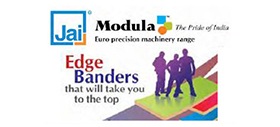Steel flakes add value to wood paints

Experimental setup employed for the thermal behaviour measurements performed with the infrared-emitting lamp.
Researchers have found that the addition of stainless-steel flakes in varying quantities to a water-based wood coating not only results in intense coloration and specific aesthetic characteristics, but also maintains the barrier protection properties of the surface, increases the abrasion resistance of the composite layer and influences the thermal behaviour of the coating.
The purpose of the research was to determine the influence of three different amounts of stainless steel flakes on the aesthetic features and durability of a waterborne wood paint. Colorimetric measurements and optical microscope observations were employed to assess the impact of this novel pigment on the overall appearance of the coatings.
Wood is valued for its abundance in nature, as well as for its specific aesthetic qualities. It is also favourably perceived as a natural and recyclable material, with no carbon-dioxide impact. However, the ligno-cellulose composition of wood renders this material particularly vulnerable to flames and degradation caused by humidity and solar radiation.
To address these practical challenges, wooden surfaces are often covered with organic coatings that safeguard the material from solar radiation, changes in humidity, chemical attacks, mechanical damage, and the proliferation of damaging microorganisms such as fungi.
Additionally, the high hardness, rigidity, and thermal endurance of nanoparticles such as nano-silica, nano-alumina, nano-clay and nano-cellulose have been selected to enhance the physical properties and reduce the water absorption of wood coatings.
Ultimately, the addition of nanomaterials such as copper nano-powders, nano-titanium, and silver promoted the antibacterial and fungicidal activity of wood paints.
Innovative pigments
However, the current wood coatings industry is focusing on the application of vibrant colour layers, obtained through the exploitation of innovative pigments that impart distinct gloss values to the protective coatings.
Stainless-steel flakes serve as an attractive resource for introducing new aesthetic features and multifunctional properties to wood paints. Recent works have highlighted the excellent contribution of this type of additive in organic matrix composite materials, whose mechanical properties have been enhanced by the stainless steel flakes.
Moreover, these fillers have been introduced into organic coatings to improve their protective properties and corrosion resistance performance. Similarly, stainless steel flakes proved to be effective for enamel coatings, which were able to refine the cracking and abrasion resistance of the composite layer.
However, the stainless-steel flakes possess a further aesthetic function, associated with the specific metallic effect they can impart to the coating, due to the particular reflective properties of their structure.
Typically, the metallic appearance in paints is achieved using aluminium-based pigments. Nevertheless, stainless steel flakes present a viable substitute due to their increased durability, superior resistance to abrasion, and enhanced aesthetic qualities.
Moreover, they exhibit greater stability than aluminium-based substances when exposed into aqueous solutions, rendering them a more effective pigment for water-based paints.
Furthermore, optical microscope observations were carried out to examine the emergence of any potential micro defects after of the test. The chemical resistance test was also performed to evaluate the effect of the filler amount on the barrier performance of the acrylic matrix.
Modifying paint
The stainless-steel flakes perform a very distinct function in modifying the appearance of wood paint. Nonetheless, it is crucial to determine whether these additives have an impact on the durability of the paint.
Thus, to evaluate the effects of various amounts of flakes, the four series of samples were subjected to accelerated degradation tests, including exposure to UV-B radiation and drastic temperature variations.
The functional pigment has no effect on the structural morphology of the coating and does not constitute a source of defectiveness in the polymeric matrix.
Thus, the stainless-steel addition can be employed to drastically alter the overall look of the coating, and modifying both its hue and reflective characteristics, offering wood paints new decorative attributes.
The colour change of the coatings caused by UV-B radiation exposure can be mitigated by the flakes, which may partially shield the UV radiation. Furthermore, the stainless-steel flakes display remarkable resilience under thermal stress and do not affect the protective characteristics of the acrylic paint, as well as on the adhesion values of the composite layer.
Certainly, this type of filler could be useful in outdoor coatings employed in environments with significant temperature changes and direct exposure to solar radiation.


Change in the appearance of the coated samples and the wooden reference panel during exposure to UV-B radiation.
High durability
Moreover, the flakes have no major impact on the barrier characteristics of the matrix; nevertheless, they can partially mask the chromatic shifts induced by the potential absorption of solutions.
As a result, the findings of the liquid resistance tests justify the application of this type of flake as a functional pigment for outdoor applications where the coatings may interact with external aggressive agents.
The mechanical tests evidenced that the stainless-steel flakes additionally offer a functional protective contribution, thereby enhancing the overall hardness of the coatings while decreasing the mass loss caused by abrasion processes.
The metallic filler not only serves as an unusual pigment resource, but it can also improve the mechanical characteristics of the acrylic matrix, ensuring the high durability of the composite layer.
Thermal analyses revealed that the flake amount has a significant impact on the thermal properties of the coating, as the behaviour of stainless-steel flakes relies on two competing contributions. The enhanced coating darkness leads to a rise in absorbed heat, while the increased light reflectance results in a reduction of coating temperatures.
Thus, the filler concentration can be properly selected to minimize or increase the heat absorbed by the substrate to which the coating must be applied. (Source: Journal of Coating Technology and Research; Vol. 21, Issue 1, 03 January 2024).
Comments

- Myanmar log unveils a Vishnu masterpiece
- IndiaWood 2024: Amplifying opportunities, manufacturing innovation
- Greenlam releasing new plywood collection
- Hettich will unveil ‘Magic Lights’ collection
- SCM is presenting cutting-edge solutions
- Woodtech’s state-of-the-art machines to make their debut
- E-Chain’s tenoner reduces downtime
- Goodtek planer is suitable for wood, non-metals
- Special edge profiling machines from Technik
- Italian accessories from Utturkar’s
- Dieffenbacher smart-tunes production efficiency
- Holytek to showcase rip saw, planer
- IPCO’s world-class steel belts for the WBP industry
- Yow Cherng machines offer quality and value
- TWMA steps into smart woodworking
- Customised cutters from Tong Fong
- Richfill introducing Edge Coat
- Cutting-edge, multi-shaft products from Wen Chih
- Ebco to showcase the latest in LED lights
- Lumber without cutting trees?
- Ligna on cusp of its golden jubilee
- Steel flakes add value to wood paints
- Leitz India now global production hub
- Homing in… Impressions from IndiaWood
- Felder India launches two new machines
- Japan’s Shoda unveils dust-free CNC router
- Luigi de Vito: Look forward to ‘Industry 5.0’
- Merino: Future of chipboard is here!
- Biesse poised for growth: locally, globally
- Piergiorgio Pozzo on ‘dynamic’ saw blade balance
- Dürr’s new paint supply system cuts losses
- Hafele unveils One-Touch mechanism
- Optimus and Modula range are best-in-class
- Katana sawblades slash cutting costs
- Woodtech’s top door-making solutions
- Canadian Wood celebrates World Wood Day
- Hanoi Expo to open in May
- Interzum adds Forum in Bergmano, Italy
- Pidilite Ventures launches ‘Building Bonds’
- Events Calendar
- Xylexpo opens for 4 days in May
- Glass bricks for structural walls?
- Climate partnership bats for wood in construction
- IKEA cuts CO2 footprint 12%
- Cefla aids innovation for Portuguese panel maker
- Lamello’s small efforts have big effect
- Rehau focuses on expansion, design excellence
- Leuco tools to enter India market
- Record year for US hardwood exports to India
- Andritz partners with Indian panelboard producers
- Versatile wood species from Canada
- CMT introduces DPX blades for beam saws
- Strong panels from agri waste
- Greenlam innovations grab industry recognition at Indiawood
- IKEA launches office furniture range
- SMEs given time to prepare for QCO
- Weinig buys grinding machine unit
- China’s wooden furniture exports decline
- Melanie Bockemühl joins Siempelkamp
- Dieffenbacher supplies another Cebro plant
- SawStop to release patented technology
- Blum opens new centre in Bengaluru
- EuroTech Vertriebs is now EuroTech Handling
- Park Hotels unveils novel design concept
- Siempelkamp acquires Febs SK
- Australian Panels orders new MDF line
- HNI Office opens in Hyderabad
- Venus launches design platform
- Koelnmesse plans new cooperations in Asia
- Revolutionary acrylic boards from Decolam
- Formica makes a formidable presence
- Hafele demonstrates the value of space
- Hettich’s Magic Lights is a design philosophy
- Special ‘thali’ storage from Utturkar’s
- IPCO reports excellent response
- Jai delights with several solutions
- Atemag expands CNC machining possibilities
- Italy’s SCM ready with Indian subsidiary
- Altendorf showcases top-line panel saws, edge banding machines
- Berndorf steel belts represent cutting-edge technology
- Fiamarc elevates interiors with Frontaline glass fittings
- How to go digital with design, manufacturing
- Ozone showcases its diverse range
- Unipegasus introduces interior décor range
- Stela deploys cutting-edge drying tech
- High-quality adhesives from Unicol
- Woodtech launches 3 versatile machines






































